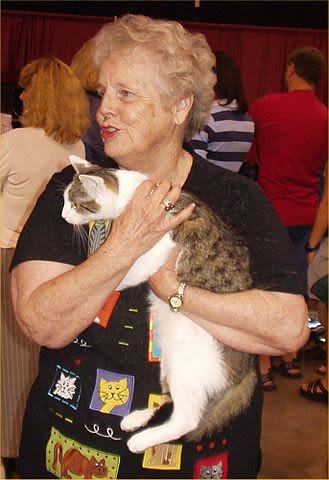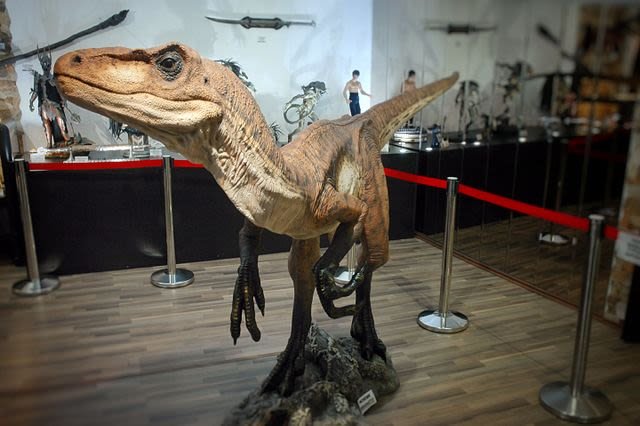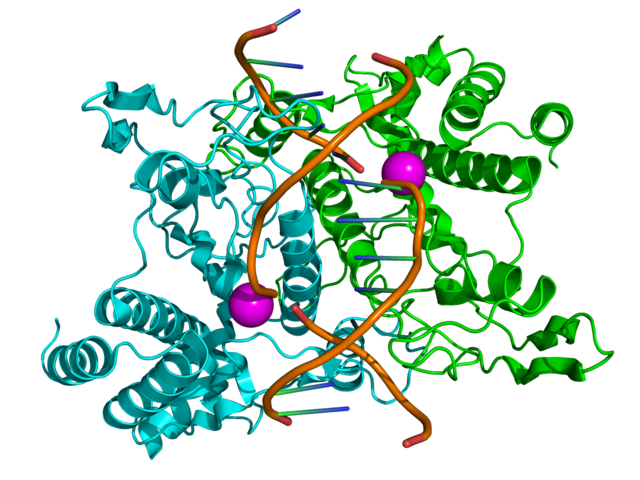DNA TECHNOLOGY: Carbon Copy Cat And Cloning
In February 2002, the first cloned cat, a kitten called cc (the typists’ abbreviation for ‘carbon copy’) made her world press debut. Cute though she was, cc highlighted some of the technological and ethical issues surrounding cloning technology. cc was cloned by transplanting DNA from Rainbow, a female three-coloured (calico) cat into an egg cell whose nucleus had been removed and then implanting this embryo into Allie, the surrogate mother. cc is genetically identical to her genetic donor, Rainbow, but she isn’t an exact physical copy, underlining the delicate balance between genetics and environment. Coat colour in cats is determined partly genetically, and partly by environmental factors, such as conditions in the womb. cc also demonstrates just how difficult and ‘wasteful’ cloning is. In their first attempt, researchers obtained the cells used to make the clone from the skin cells of a donor cat. Eggs from other cats were used for the next step. Their chromosomes were removed and replaced with the DNA from the skin cells, creating cloned embryos that were then transplanted into surrogate mothers.

In total, 188 such nuclear-transfer procedures were performed, which resulted in 82 cloned embryos that were transferred into seven recipient females. Only one cat became pregnant, with a single embryo. But this pregnancy miscarried and the embryo was surgically removed after 44 days. In the next attempt the scientists tried using cells from ovarian tissue to receive the DNA from the cat to be cloned.
Five cloned embryos made in this way were implanted into a single surrogate mother. Pregnancy was confirmed by ultrasound after 22 days and a kitten was born on 22 December 2001, 66 days after the embryo was transferred. So, out of 87 implanted cloned embryos, cc is the only one to survive. This is comparable to the success rate in sheep, mice, cows, goats and pigs, but would be unacceptably low for people.
THE NEW GENETICS
Genetics has come a long way since the days of Mendel and his pea experiments. A vast amount of scientific progress has been made in the past 40 years but these advances have been fraught with moral and ethical dilemmas. Learning about the ‘new genetics’ cannot be done without considering these and doing some deep thinking. So, what is involved in the new genetics?
TECHNIQUES FOR DISCOVERING THE GENETIC BASIS OF DISEASE
If you want to understand the causes of a particular genetic disease, you must first identify and then locate the gene or genes involved. Some of the techniques used to locate genes are described below. All lifestyle diseases have some sort of genetic component. One person may smoke cigarettes for 60 years and not develop lung cancer, but another person does. Why the difference? It must be in the genes/alleles an individual possesses. For example, several different genes are associated with increased breast cancer risk: if a woman carries a variant allele of one of these genes, her risk of developing breast cancer at a young age is greatly increased. There are many ethical dilemmas here:
- How much should people be told?
- How much do they want to know?
- Who owns this information? The individual? The doctors?
- How much should financial institutions such as mortgage and life insurance companies be told?
Environmental factors influence how genes are expressed; just because someone has a particular gene sequence, it cannot be used to say definitely what may happen to them in the future.
Gene-hunting techniques are also used to identify genes in order to extract them from one organism for transfer to another – the process by which transgenic organisms are produced.
CLONING GENES AND MAKING TRANSGENIC ORGANISMS
It has been possible for some time to take a single gene from one organism and put it into the DNA of another, so that the gene is ‘adopted’ and expressed by the recipient organism. To date, this has been most successful in plants and lower animals such as invertebrates, although some mammalian transgenic organisms have been developed. Some of the techniques used in gene cloning are described below.

GENE THERAPY
If someone has a genetic disease, they may have a variant allele in just one gene, but this will be present in every one of their body cells. If that allele makes a non-functional protein, it is theoretically possible to treat their disease by gene therapy. The basic principle is the same as that used to produce a transgenic organism. A copy of the healthy allele of the gene, which can code for the functional protein, could be transferred into body cells to restore normal gene expression. Human gene therapy, described vividly below, has not met with great success, although many researchers hope that the setbacks and problems may be overcome in the future.
THE GENOME AND GENE SEQUENCING
Finding a particular gene, or cloning it, is easier if you have a map to look at to start with. It wasn’t until the 1990s that DNA sequencing technology developed and became sufficiently automated for whole chromosomes and whole genomes to be sequenced. A major advance was the publication of the complete sequence of the human genome in April 2003, the culmination of 13 years’ intensive effort. Several other mammalian genomes have now also been sequenced.
Vast computer databases are now available online to scientists all over the world to give them information about human genes and the variations that can exist in those genes. In 2006, the International HapMap Consortium published a comprehensive catalogue of human genetic variation, for researching the genes involved in common diseases, such as asthma, diabetes, cancer and heart disease. There is more about genomes and gene sequencing below.
WHOLE ORGANISM CLONING
Dolly the sheep was the first mammal to be cloned, in 1997, and cc the cat was cloned in 2002. 2005 saw the first dog clone – Snuppy, an Afghan pup born in South Korea. The following animals have also been successfully cloned (year of first cloning in brackets): goats (2000), cows (2001), mice (1998), pigs (2000), cats (2002), rabbits (2003), mules (2003), rats (2003), horses (2003), deer (2003), ferrets (2006) and a gaur (2001). The gaur was the first endangered animal to be cloned but it died shortly after birth.
Fewer ‘ordinary’ species are now cloned – the point of the early clones was to perfect the technique. As described below, in the future, animal cloning will have two main purposes:
- Conservation of endangered species. If animals threatened with extinction can be cloned, this could be used to rescue or save a species from extinction.
- Production of pharmaceuticals or organs for transplantation. This is controversial, but it is possible to clone sheep and cows and then modify the embryos at an early stage so that the cloned animal produces drugs or useful proteins in its milk. One suggestion is that cows could be modified to produce milk very similar to human breast milk to feed to babies.
Note than no primates have been cloned so far. It took over 300 attempts to get Dolly – the other attempts resulted in deformed, abnormal fetuses. Not surprisingly, the ethical dilemmas of human cloning are enormous. Although, it is technically possible to clone a human embryo, and this is done to produce stem cells, it is in most countries against the law to implant a cloned human embryo into a female’s uterus for it to develop into a baby There have been wild claims that this has already been done, but none has been proven. Just the practice of using embryos to harvest stem cells has created huge public outcry and controversy.
STEM CELL CLONING
Stem cells are cells in the body that are capable of differentiating into any type of body cell, given the right signals. Adults have very few stem cells, but they are plentiful in early-stage embryos. This why very-early-stage embryos left over from IVF treatment are used to harvest stem cells for research. A controversial process that is highly regulated, which concentrates on stem cell cloning, concludes this chapter.

Genetic screening and diagnosis
In one of my previous post on genetics, I explained how singer Woody Guthrie, along with other sufferers, only found that he had Huntington’s disease when the symptoms appeared. By that time, he was about 40 and had already had a son to whom he could have passed on the disease, Now it is possible to screen new-born babies for an increasing list of genetic abnormalities.
All babies in the UK are tested routinely for phenylketonuria. This condition and the heel test that detects it will be described later. Cystic fibrosis, sickle cell anaemia and Tay Sachs disease can also be detected by screening techniques. A simple blood test can tell Tay Sachs carriers from non-carriers. Blood samples can be analysed by either enzyme assay or DNA studies. The enzyme assay is a biohemical test that measures the level of Hex-A (a vital enzyme called hexosaminidase A) in a person’s blood. Carriers have less Hex-A in their body fluid and cells than non-carriers.
Screening can now also be done for genes that increase the risk of developing some types of cancer. Knowing that you have a gene that makes it more likely that you will get cancer, or that you might be able to pass on a genetic disease to your children, can be difficult to cope with and genetic screening tests are usually done in conjunction with lengthy counselling.
LOCATING GENES
The first problem that researchers tackle is finding the gene they are interested in. Every human body cell contains 46 chromosomes, each having several thousand genes. So how, for example, do you go about finding a gene that you suspect is involved in asthma? Let’s look at three different approaches.
- Isolate the gene from the rest of the genome. This has been compared with looking for a needle in a haystack, when the needle is also made from straw. However, there are several sophisticated techniques that can be used to map chromosomes. For instance, if you know part of the base sequence in the required gene, you can make a genetic probe. This is a single-stranded piece of matching DNA labelled with a radioactive or fluorescent marker. When mixed with the genomic DNA (DNA from the genome) – in the right conditions – the probe seeks out the complementary base sequence and binds to it, showing you exactly where the gene is. These techniques can now be combined with the vast database produced by the Human Genome Project. This database of all the genes in the human genome is freely available to all scientists, and they can look up likely genes and gain predictions of function, using computer programs that construct the most likely protein from the DNA sequence. The possibilities are extending so fast, it is impossible to give more than a brief overview here.
- Use messenger RNA. If you can isolate the mRNA molecule that is a copy of the gene that you are trying to find, you can use it as a genetic probe as described above. You can also use it to make a DNA copy using the enzyme reverse transcriptase. This means essentially that you make an ‘artificial’ gene. For example, you could find the mRNA that codes insulin in the cells where the insulin gene is expressed – the cells in the islets of Langerhans. DNA made from mRNA is called complementary DNA, or eDNA. Artificial genes are shorter than those in the genome because they contain no introns.
- Work backwards from the protein. If you work out the amino acid sequence of the desired protein – a relatively easy process – you can make a piece of DNA that codes for it. It would obviously be a tedious process to make a large gene, but now there is equipment that can synthesise artificial DNA quickly and easily. The end product of this process is also a short, artificial gene made of eDNA.
CLONING GENES AND MAKING TRANSGENIC ORGANISMS
The first step in cloning a gene, once you have located it, is to remove it from the host genome. Enzymes are the tools of the trade here.
MANIPULATING DNA USING ENZYMES
Many different enzymes are used routinely in gene cloning, including:
- Exonucleases. These are used to remove a terminal base from a DNA sequence – this is useful in the analysis of base sequences.
- DNases. These make random cuts in DNA, chopping it into various sized fragments – this is also useful for DNA fingerprinting.
- Kinases. These enzymes add groups such as phosphates to DNA – this helps with labelling and analysis, particularly when radioactively labelled phosphates are used.
- Polymerases. These synthesise nucleic acid molecules from nucleotides. This is essential for the polymerase chain reaction (PCR) that is used to amplify DNA sequences for analysis. Reverse transcriptase is a polymerase that makes DNA from RNA. It occurs naturally in retroviruses such as the human immunodeficiency virus, HIV. Restriction enzymes and DNA ligases are particularly useful.
Restriction enzymes
Restriction enzymes can be thought of as ‘molecular scissors’ – they cut DNA strands at specific points. More properly called restriction endonucleases, they are made by bacteria in response to attack by viruses called bacteriophages. Their name reflects their function: they restrict damage by chopping bacteriophage DNA into smaller, non-infectious fragments, and they make their cuts inside the nucleic acid molecules.
There are many different endonuclease enzymes, produced originally by different species of bacteria. Each enzyme cuts DNA at a different base sequence, a point known as the recogntion site. The enzymes make staggered cuts in the DNA, commonly called ‘sticky ends’. These can combine with complementary sticky ends and this allows lengths of DNA that have been removed from one organ to be spliced – inserted – into the DNA of another. EcoRI, for example, is a common endonuclease isolated from the bacterium Escherichia coli. This is a very popular enzyme with genetic engineers because it is readily available. It is also reliable: it cuts DNA at its recognition site precision, showing very little star activity (cutting DNA at sites other than the recognition site).

You might be asking. ‘If restriction enzymes cut DNA, why is the bacterium’s own DNA not damaged?’ The answer lies in a process called methylation: the bacteria add a methyl (– CH3) group to the sequences in their own DNA that could act as recognition sites. This prevents the restriction enzymes doing any damage, presumably because the methylated region no longer fits into the active site of the enzyme.
I will continue from here next time.
Thanks for reading.
REFERENCES
https://www.newscientist.com/article/dn1931-cloners-create-worlds-first-copy-cat/
https://www.britannica.com/list/cc-the-first-cloned-cat
https://en.wikipedia.org/wiki/CC_(cat)
https://www.sciencedirect.com/science/article/pii/S0884217515328513
https://www.nigms.nih.gov/education/Booklets/the-new-genetics/Pages/Home.aspx
https://en.wikipedia.org/wiki/Disease_gene_identification
https://www.hindawi.com/journals/bmri/2015/461524/
http://www.nature.com/scitable/topicpage/cytogenetic-methods-in-diagnosing-genetic-disorders-875
https://www.nature.com/scitable/topic/genes-and-disease-17
https://www.ncbi.nlm.nih.gov/pmc/articles/PMC6279436/
https://www.learner.org/courses/biology/support/redbioact13.pdf
https://en.wikipedia.org/wiki/Molecular_cloning
https://knowgenetics.org/transgenic-organisms/
https://www.asgct.org/education/gene-therapy-basics
https://en.wikipedia.org/wiki/Gene_therapy
https://ghr.nlm.nih.gov/primer/therapy/genetherapy
http://www.nature.com/scitable/topicpage/dna-sequencing-technologies-key-to-the-human-828
https://www.wired.com/story/you-can-get-your-whole-genome-sequenced-but-should-you/
https://www.sciencedirect.com/topics/medicine-and-dentistry/genome-sequencing
https://en.wikipedia.org/wiki/Whole_genome_sequencing
This post has been rewarded with an upvote from city trail as part of Neoxian City Curation program
 . We are glad to see you using #neoxian tag in your posts. If you still not in our discord, you can join our Discord Server for more goodies and giveaways.
. We are glad to see you using #neoxian tag in your posts. If you still not in our discord, you can join our Discord Server for more goodies and giveaways.
Do you know that you can earn NEOXAG tokens as passive income by delegating to @neoxiancityvb. Here are some handy links for delegations: 100SP, 250SP, 500SP, 1000SP. Read more about the bot in this post. Note: The liquid neoxag reward of this comment will be burned and stake will be used for curation.
Thanks, @neoxian-city. I'll join your discord server ASAP.
Hi, thanks for the post! I have included a link and a short description in my daily Science and technology digest, and you'll receive a 10% share of that post's rewards.
Thanks, @remlaps-lite. I do appreciate.
This post has been voted on by the SteemSTEM curation team and voting trail. It is elligible for support from @curie and @minnowbooster.
If you appreciate the work we are doing, then consider supporting our witness @stem.witness. Additional witness support to the curie witness would be appreciated as well.
For additional information please join us on the SteemSTEM discord and to get to know the rest of the community!
Thanks for having used the steemstem.io app and included @steemstem in the list of beneficiaries of this post. This granted you a stronger support from SteemSTEM.
I shared this post from my Twitter account: https://twitter.com/lupafilotaxia/status/1210296315751600128